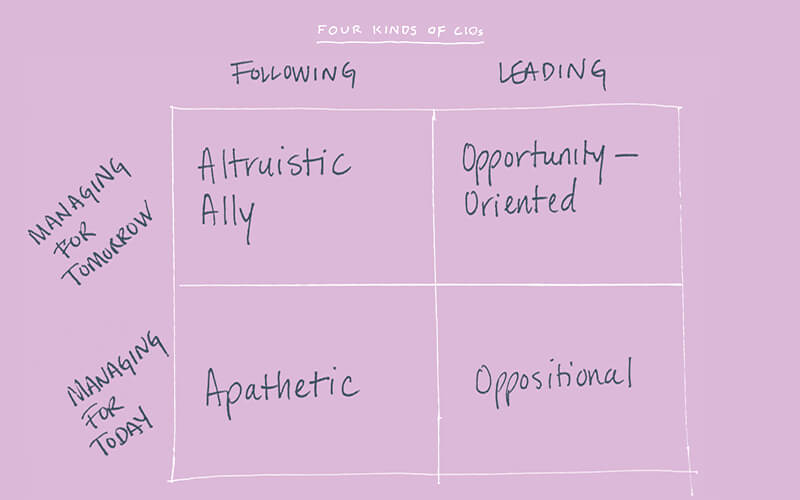Last week, while doing research for a customer and in a local CIO peer group that I’m in, the topic came up about the role of the Chief Information Officer (CIO) in Advanced Marketing, Digital Experience and Connected Product projects.
Throughout the past two decades we’ve consulted in this area, the role of the CIO has changed. Four distinct personas have emerged.
The Opportunity-Oriented CIO
These are CIOs that have been entrusted by the business to lead a digital initiative. Because of the combination of technology capabilities, business instincts, and entrepreneurial leadership, these CIOs create opportunities for the business and are capable of leading from incubation into early-stage adoption.
When I think of this CIO, I think of Terry Kline from Navistar. Last time I visited Navistar for a conversation with Terry, there was a flag outside the global headquarters with the OnCommand Connection (OCC) logo, quite an accomplishment for a service line under the leadership of a CIO.
The Altruistic Ally CIO
These CIOs view themselves as a partner with the business. They offer advice, material support and technical knowledge, but they allow the business to lead the digital initiative.
Project funding may come from the line of business. IT may provide technical talent for platform support or help vet partners. IT is viewed as a trusted partner, friendly to the initiative, but without a deep enough talent pool or experience-set to build a technology-based product or service.
The Apathetic CIO
This often begins as a small-scale Digital Experience or Connected Product MVP or Proof of Concept – and often as a design project. The initial technology ask is small (a couple servers or a small Azure/AWS instance). Often there is a small economic footprint at the beginning, and the CIO fails to recognize marketing or product development as new and significant internal customer (like supply chain, manufacturing, logistics, finance, etc.).
We have had multiple customers where the CIO was in the middle of a global SAP/ERP rollout and couldn’t be bothered with this cloud/IoT initiative, not realizing that it would become a significant future platform for the company. In many cases, these CIOs later try to play catch-up and demonstrate to the business their relevancy to the project that has already become real without them.
The Oppositional CIO
These CIOs see the company’s digital initiatives as noise or a distraction from the larger goals of IT. Instead of being supportive from a distance (Altruistic) or neutral (Apathetic) they engage in active opposition. They often use the language of IT to demonstrate that this new project is ridden with peril: security, cost, requirements, predictability (common when moving from a waterfall to agile process), change control, and so on.
They will ask that these projects be put on the IT backlog along with “everything else we have to do” and the project will die there because the metrics of IT will not support it bubbling to the top of the list. Oftentimes, there will a point of pride for these CIOs that they are managing to amazing cost and reliability metrics. They will talk about ‘Shadow IT’ instead of supporting the business in digital transformation. Since they perceive the project as a technology platform, they want to own it but they ultimately don’t support it and become defensive.
It might go without saying, but this CIO is on the verge of losing their job. In these cases, the business wants to adopt new technology to support strategic initiatives and IT is viewed as an active impediment to change.
Stewart McCutcheon, when he was speaking on a panel I chaired at an Evanta CIO event a few years ago said,
“In the era of the cloud, with consultants, anything is possible. We better get on the side of the business to help it happen or they will do it without us.”
As I recapped this conversation with Andy Van Solkema, our VP of Digital Strategy & Experience, a 2×2 emerged (which is often the case with Andy). One axis is of a partnering mindset and the second axis is a strong capability/point of view.

IT leaders do have a choice what kind of partnership they will have with the business. This has been the mantra for decades, but with the opportunities in strategy, digital, mobile, IoT, analytics, AI, and cloud; there has never been a better time to demonstrate how the CIO brings value to the organization.
I was in a customer meeting on Friday and mentioned to the IT lead for an IoT product that is about to launch that he was entering rarefied air – the IT leader that has direct product ownership for a revenue and relevance initiative for his company. We talked about the conversations of the past week, and how IT broadly engages in digital initiatives.
It sounded like a good blog post, so here you go Tom. Enjoy the read – you know who you are and what kind of leader you aspire to be.


